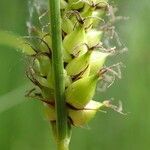Rhizome with ligneous and slender stolons. Culms 20-50 cm tall, triquetrous, rather slender, smooth on lower part and scabrid near top, clothed with red-brown and bladeless sheaths at base, one side of sheaths disintegrating into reticulate fibers. Leaves slightly longer than or equaling culm, blades 2-3 mm wide, stiff, longitudinally furrowed on costa, involute on margins, mid-sheathed. Involucral bracts leafy, lower involucral bracts longer than inflorescence, shortly sheathed, upper involucral bracts rather short, nearly not sheathed. Spikes 3-6; terminal 1-3 male, slightly contiguous, clavate, 1-2.5 cm, nearly sessile; remaining spikes female, remote, ovate or oblong, 1-3 × ca. 1 cm, slightly densely many flowered, pedunculate, peduncle less than 1 cm. Female glumes fuscous laterally, pale at middle, ovate or narrowly ovate, 4.5-5 mm, membranous, costate, apex acuminate, aristate. Utricles brown-green, obliquely patent, longer than glume (excluding awn), ovoid, slightly inflated trigonous, ca. 5 mm, leathery, glabrous, with several rather concave veins, base broadly cuneate, apex abruptly contracted into a slightly broad and short beak, orifice shortly 2-toothed, teeth straight, smooth. Nutlets broadly obovate or subelliptic, trigonous, ca. 2 mm, base stipitate, apex slightly long mucronate; style base not thickened; stigmas 3. Fl. and fr. Apr-Jun.
More
Plants colonial; rhizomes long-creeping. Culms central, slender, trigonous, 25–65 cm, ± scabrous-angled. Leaves: basal sheaths reddish purple, apex of inner band finely ciliate; ligules 0.7–1.9 mm; blades green, M-shaped, not septate-nodulose, 1.6–3.5(–4) mm wide, smooth abaxially, glabrous or, sometimes, lightly pubescent on apex of inner band of distal sheaths. Inflorescences 6–20 cm; rachis beyond proximal pistillate spikes sharp-angled, finely scabrous; proximal (1–)2(–3) spikes pistillate, not or barely overlapping, ascending; distal spikes erect; terminal 1–3 spikes staminate. Pistillate scales ovate, apex acute to acuminate-awned, glabrous, scabrous-ciliate apically. Perigynia ascending, ca. 14–18-veined near base, veins impressed, broadly ovoid, (4–)4.5–6.5 × 1.9–3.5 mm, dull, glabrous; beak 0.9–1.3 mm, bidentulate, teeth straight, 0.5–0.8 mm.







